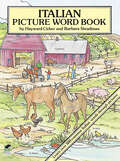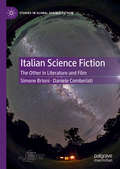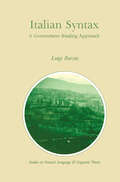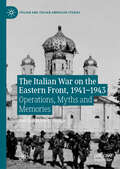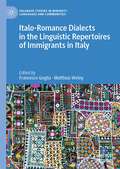- Table View
- List View
Italian Modernities: Competing Narratives of Nationhood (Italian and Italian American Studies)
by Bjørn Thomassen Rosario ForlenzaThis book argues that Italy represents a privileged entry point into the comparative analysis of ideologies and experiences of modernity. The book compares how thinkers and politicians belonging to different ideological clusters - Liberalism, Communism, Fascism, Chistian Democracy - came to formulate multiple and often antagonistic visions of Italy's road to the modern. By revisiting Italian political history from the late nineteenth century until the present with a focus on transition periods, Italian Modernities explores how competing historical narratives influenced shifting understandings of Italian nationhood, thus foregrounding the active role of memory politics in the formulation of multiple modernities.
Italian Picture Word Book
by Barbara Steadman Hayward CirkerHere’s a pleasant and effective way for students of Italian to build and strengthen vocabulary skills. The book consists of 15 carefully rendered scenes (14 double-page and one single-page), each devoted to a different theme or topic.Lo zoo: At the zooLa fattoria: On the farmLa camera di una ragazza: Girl’s bedroomLa camera di un ragazzo: Boy’s bedroomL’aula scolastica: ClassroomIl soggiorno: Living roomIl bagno: BathroomL’ora di pranzo: At dinnerIl supermercato: SupermarketLa spiaggia: At the beach… and five more.Each illustration contains dozens of common objects, clearly labeled in Italian. By studying the illustrations, students can learn over 500 words for common household items, clothing, foods, vehicles, furniture, names of animals, parts of the body, types of stores and public buildings, and much more.To help reinforce words and meanings, all the scenes in this book are ideal for coloring. In addition, a complete list of Italian words (with definite articles) and English translations will be found at the back of the book. The result is an attractive and useful language resource that will appeal to any student of basic Italian, child or adult.
Italian Science Fiction: The Other in Literature and Film (Studies in Global Science Fiction)
by Simone Brioni Daniele ComberiatiThis book explores Italian science fiction from 1861, the year of Italy’s unification, to the present day, focusing on how this genre helped shape notions of Otherness and Normalness. In particular, Italian Science Fiction draws upon critical race studies, postcolonial theory, and feminist studies to explore how migration, colonialism, multiculturalism, and racism have been represented in genre film and literature. Topics include the role of science fiction in constructing a national identity; the representation and self-representation of “alien” immigrants in Italy; the creation of internal “Others,” such as southerners and Roma; the intersections of gender and race discrimination; and Italian science fiction’s transnational dialogue with foreign science fiction. This book reveals that though it is arguably a minor genre in Italy, science fiction offers an innovative interpretive angle for rethinking Italian history and imagining future change in Italian society.
Italian Sexualities Uncovered, 1789-1914 (Genders and Sexualities in History)
by Lucy Riall Chiara Beccalossi Valeria P. BabiniBringing together an interdisciplinary group of scholars, this volume explores nineteenth-century Italian sexualities from a variety of viewpoints, illuminating in particular personal and political relationships, same-sex desires, gender roles that defy societal norms, sexual behaviours of different classes and transnational encounters.
Italian Syntax: A Government-Binding Approach (Studies in Natural Language and Linguistic Theory #1)
by L. BurzioIn the course of our everyday lives, we generally take our knowledge of language for granted. Occasionally, we may become aware of its great practical importance, but we rarely pay any attention to the formal properties that language has. Yet these properties are remarkably complex. So complex that the question immediately arises as to how we could know so much. The facts that will be considered in this book should serve well to illustrate this point. We will see for example that verbs like arrivare 'arrive' and others like telefonare 'telephone', which are superficially similar, actually differ in a large number of respects, some fairly well known, others not. Why should there be such differencces. we may ask. And why should it be that if a verb behaves like arrivare and unlike tetefonare in one respect. it will do so in all others consistently, and how could everyone know it? To take another case, Italian has two series of pronouns: stressed and unstressed. Thus, for example, alongside of reflexive se stesso 'himself which is the stressed form. one finds si which is unstressed but otherwise synonymous. Yet we will see that the differences between the two could not simply be stress versus lack of stress, as their behavior is radically different under a variety of syntactic conditions.
The Italian War on the Eastern Front, 1941–1943: Operations, Myths and Memories (Italian and Italian American Studies)
by Bastian Matteo SciannaThe Italian Army’s participation in Hitler’s war against the Soviet Union has remained unrecognized and understudied. Bastian Matteo Scianna offers a wide-ranging, in-depth corrective. Mining Italian, German and Russian sources, he examines the history of the Italian campaign in the East between 1941 and 1943, as well as how the campaign was remembered and memorialized in the domestic and international arena during the Cold War. Linking operational military history with memory studies, this book revises our understanding of the Italian Army in the Second World War.
Italian Women's Experiences with American Consumer Culture, 1945–1975: The Italian Mrs. Consumer (Italian and Italian American Studies)
by Jessica L. HarrisThis book analyzes the spread of American female consumer culture to Italy and its influence on Italian women in the postwar and Cold War periods, eras marked by the political, economic, social, and cultural battle between the United States and Soviet Union. Focusing on various aspects of this culture—beauty and hygiene products, refrigerators, and department stores, as well as shopping and magazine models—the book examines the reasons for and the methods of American female consumer culture’s arrival in Italy, the democratic, consumer capitalist messages its products sought to “sell” to Italian women, and how Italian women themselves reacted to this new cultural presence in their everyday lives. Did Italian women become the American Mrs. Consumer? As such, the book illustrates how the modern, consuming American woman became a significant figure not only in Italy’s postwar recovery and transformation, but also in the international and domestic cultural and social contests for the hearts and minds of Italian women.
Italian Workbook For Dummies
by Teresa L. PicarazziLearning Italian is easy with Dummies Italian Workbook For Dummies is for beginners who want to get started learning Italian. Packed with foundational grammar and integrated vocab, Italian Workbook For Dummies will set new language learners on their way to a wonderful experience learning this beautiful romance language. This book provides valuable practice lessons and exercises so that you can learn to write and communicate in Italian with confidence. Italian Workbook For Dummies is also an excellent supplement for any student looking to boost their classroom learning. With the tried-and-true expertise of Dummies, you'll move through the Italian basics with ease. Get introduced to the Italian language, including basic grammar and pronunciation Complete exercises to improve your ability to write and speak in Italian Learn important phrases for travelling, doing business, and studying in Italy Build your vocabulary, discover common slang, and learn authentic expressionsThis is the perfect Dummies guide for those who are brand new to the Italian language, regardless of age or background. Gain the confidence you need to interact in Italiano!
Italian Workbook For Dummies
by Teresa L. PicarazziLearning Italian is easy with Dummies Italian Workbook For Dummies is for beginners who want to get started learning Italian. Packed with foundational grammar and integrated vocab, Italian Workbook For Dummies will set new language learners on their way to a wonderful experience learning this beautiful romance language. This book provides valuable practice lessons and exercises so that you can learn to write and communicate in Italian with confidence. Italian Workbook For Dummies is also an excellent supplement for any student looking to boost their classroom learning. With the tried-and-true expertise of Dummies, you'll move through the Italian basics with ease. Get introduced to the Italian language, including basic grammar and pronunciation Complete exercises to improve your ability to write and speak in Italian Learn important phrases for travelling, doing business, and studying in Italy Build your vocabulary, discover common slang, and learn authentic expressionsThis is the perfect Dummies guide for those who are brand new to the Italian language, regardless of age or background. Gain the confidence you need to interact in Italiano!
Italienische Literaturgeschichte
Italien klassisches Ziel deutscher Bildungsreisen. So ist auch die italienische Literatur seit jeher ein Muss für alle Kulturinteressierten. Von Dante, Petrarca und Boccaccio über Manzoni und Leopardi bis Pirandello, Calvino, Fo, Eco und Tabucchi werden alle bedeutenden Autoren, ihre Werke und ihre Epoche vorgestellt. In der 3. Auflage um die letzten 20 Jahre und das Genre des Kriminalromans erweitert.
Italienische Literaturgeschichte
Die Geschichte der italienischen Literatur von den Anfängen bis zur Gegenwart - kompakt und informativ. Historische Hintergründe, große Autoren und wichtige Werke, von Dante, Petrarca und Boccaccio bis Pirandello, Calvino, Fo und vielen anderen. Die wesentlichen Facetten des literarischen Lebens in Italien, mit zahlreichen Illustrationen aus Malerei, Architektur, Theater und Film.
Italo Calvino: Letters, 1941-1985
by Italo Calvino Martin Mclaughlin Michael WoodThis is the first collection in English of the extraordinary letters of one of the great writers of the twentieth century. Italy's most important postwar novelist, Italo Calvino (1923-1985) achieved worldwide fame with such books as Cosmicomics, Invisible Cities, and If on a Winter’s Night a Traveler. But he was also an influential literary critic, an important literary editor, and a masterful letter writer whose correspondents included Umberto Eco, Primo Levi, Gore Vidal, Leonardo Sciascia, Natalia Ginzburg, Michelangelo Antonioni, Pier Paolo Pasolini, and Luciano Berio. This book includes a generous selection of about 650 letters, written between World War II and the end of Calvino’s life. Selected and introduced by Michael Wood, the letters are expertly rendered into English and annotated by well-known Calvino translator Martin McLaughlin.The letters are filled with insights about Calvino’s writing and that of others; about Italian, American, English, and French literature; about literary criticism and literature in general; and about culture and politics. The book also provides a kind of autobiography, documenting Calvino’s Communism and his resignation from the party in 1957, his eye-opening trip to the United States in 1959-60, his move to Paris (where he lived from 1967 to 1980), and his trip to his birthplace in Cuba (where he met Che Guevara). Some lengthy letters amount almost to critical essays, while one is an appropriately brief defense of brevity, and there is an even shorter, reassuring note to his parents written on a scrap of paper while he and his brother were in hiding during the antifascist Resistance.This is a book that will fascinate and delight Calvino fans and anyone else interested in a remarkable portrait of a great writer at work.
Italo Calvino: Letters, 1941-1985
by Italo Calvino Martin Mclaughlin Michael WoodThis is the first collection in English of the extraordinary letters of one of the great writers of the twentieth century. Italy's most important postwar novelist, Italo Calvino (1923-1985) achieved worldwide fame with such books as Cosmicomics, Invisible Cities, and If on a Winter’s Night a Traveler. But he was also an influential literary critic, an important literary editor, and a masterful letter writer whose correspondents included Umberto Eco, Primo Levi, Gore Vidal, Leonardo Sciascia, Natalia Ginzburg, Michelangelo Antonioni, Pier Paolo Pasolini, and Luciano Berio. This book includes a generous selection of about 650 letters, written between World War II and the end of Calvino’s life. Selected and introduced by Michael Wood, the letters are expertly rendered into English and annotated by well-known Calvino translator Martin McLaughlin.The letters are filled with insights about Calvino’s writing and that of others; about Italian, American, English, and French literature; about literary criticism and literature in general; and about culture and politics. The book also provides a kind of autobiography, documenting Calvino’s Communism and his resignation from the party in 1957, his eye-opening trip to the United States in 1959-60, his move to Paris (where he lived from 1967 to 1980), and his trip to his birthplace in Cuba (where he met Che Guevara). Some lengthy letters amount almost to critical essays, while one is an appropriately brief defense of brevity, and there is an even shorter, reassuring note to his parents written on a scrap of paper while he and his brother were in hiding during the antifascist Resistance.This is a book that will fascinate and delight Calvino fans and anyone else interested in a remarkable portrait of a great writer at work.
Italo-Romance Dialects in the Linguistic Repertoires of Immigrants in Italy (Palgrave Studies in Minority Languages and Communities)
by Francesco Goglia Matthias WolnyThis edited book brings together experts on the sociolinguistics of immigration with a focus on the Italo-Romance dialects. Sociolinguistic research on immigrant communities in Italy has widely studied the acquisition and use of Italian as L2 by first-generation immigrants, the maintenance of immigrant languages and code-switching between Italian and the immigrant languages. However, these studies have mostly ignored or neglected to investigate immigrant speakers’ use of Italo-Romance dialects, their awareness of the sociolinguistic situation of majority and minority languages, and their attitudes towards them. Given the important role of Italo-Romance dialects in everyday communication and as a marker of regional identity, this book aims to fill this gap and understand more about the role that these languages play in the linguistic repertoire of immigrants. This book will be of interest to students and scholars of sociolinguistics, minority languages, multilingualism, migration, and social anthropology.
Italy and the Classical Tradition: Language, Thought and Poetry 1300-1600
by Bloomsbury PublishingItaly's original fascination with its cultural origins in Greece and Rome first created what is now known as 'the Classical tradition' - the pervasive influence of ancient art and thought on later times. In response to a growing interest in Classical reception, this volume provides a timely reappraisal of the Greek and Roman legacies in Italian literary history. There are fresh insights on the early study of Greek and Latin texts in post-classical Italy and reassessments of the significance attached to ancient authors and ideas in the Renaissance, as well as some innovative interpretations of canonical Italian authors, including Dante, Petrarch and Alberti, in the light of their ancient influences and models. The wide range of essays in this volume - all by leading specialists - should appeal to anyone with an interest in Italian literature or the Classical tradition. Italy's early fascination with its Hellenic and Roman origins created what is now called 'the classical tradition'.This book focuses on the role of the Greek and Latin languages and texts in Italian humanist thought and Renaissance poetry: how ancient languages were mastered and used, and how ancient texts were acquired and appropriated. Fresh perspectives on the influences of Aristotle, Plutarch and Virgil accompany innovative interpretations of canonical Italian authors - including Dante, Petrarch and Alberti - in the light of their classical models. Treatments of more specialized forms of writing, such as the cento and commentary, and some opening chapters on linguistic history also prompt reassessment of Renaissance perceptions of both Greece and Rome in relation to early modern Latin and vernacular culture. The collection as a whole highlights the importance of Italy's unique legacy of antiquity for the history of ideas and philology, as well as for literary history. The essays in this volume, all by leading specialists, are supplemented by a detailed introduction and a subject bibliography.
Italy and the Classical Tradition: Language, Thought and Poetry 1300-1600
by Bloomsbury PublishingItaly's original fascination with its cultural origins in Greece and Rome first created what is now known as 'the Classical tradition' - the pervasive influence of ancient art and thought on later times. In response to a growing interest in Classical reception, this volume provides a timely reappraisal of the Greek and Roman legacies in Italian literary history. There are fresh insights on the early study of Greek and Latin texts in post-classical Italy and reassessments of the significance attached to ancient authors and ideas in the Renaissance, as well as some innovative interpretations of canonical Italian authors, including Dante, Petrarch and Alberti, in the light of their ancient influences and models. The wide range of essays in this volume - all by leading specialists - should appeal to anyone with an interest in Italian literature or the Classical tradition. Italy's early fascination with its Hellenic and Roman origins created what is now called 'the classical tradition'.This book focuses on the role of the Greek and Latin languages and texts in Italian humanist thought and Renaissance poetry: how ancient languages were mastered and used, and how ancient texts were acquired and appropriated. Fresh perspectives on the influences of Aristotle, Plutarch and Virgil accompany innovative interpretations of canonical Italian authors - including Dante, Petrarch and Alberti - in the light of their classical models. Treatments of more specialized forms of writing, such as the cento and commentary, and some opening chapters on linguistic history also prompt reassessment of Renaissance perceptions of both Greece and Rome in relation to early modern Latin and vernacular culture. The collection as a whole highlights the importance of Italy's unique legacy of antiquity for the history of ideas and philology, as well as for literary history. The essays in this volume, all by leading specialists, are supplemented by a detailed introduction and a subject bibliography.
Italy Before Rome: A Sourcebook (Routledge Sourcebooks for the Ancient World)
by Katherine McDonaldThis book brings together sources translated from a wide variety of ancient languages to showcase the rich history of pre-Roman Italy, including its cultures, politics, trade, languages, writing systems, religious rituals, magical practices, and conflicts. This book allows readers to access diverse sources relating to the history and cultures of pre-Roman Italy. It gathers and translates sources from both Greek and Latin literature and ancient inscriptions in multiple languages and gives commentary to highlight areas of particular interest. The thematic organisation of this sourcebook helps readers to make connections across languages and communities, and showcases the interconnectedness of ancient Italy. This book includes maps, a timeline, and guides to further reading, making it accessible to students and other readers who are new to this subject. Italy Before Rome is aimed at undergraduate and graduate students, including those who have not studied the ancient world before. It is also intended to be useful to researchers approaching this material for the first time, and to university and schoolteachers looking for an overview of early Italian sources.
Italy Before Rome: A Sourcebook (Routledge Sourcebooks for the Ancient World)
by Katherine McDonaldThis book brings together sources translated from a wide variety of ancient languages to showcase the rich history of pre-Roman Italy, including its cultures, politics, trade, languages, writing systems, religious rituals, magical practices, and conflicts. This book allows readers to access diverse sources relating to the history and cultures of pre-Roman Italy. It gathers and translates sources from both Greek and Latin literature and ancient inscriptions in multiple languages and gives commentary to highlight areas of particular interest. The thematic organisation of this sourcebook helps readers to make connections across languages and communities, and showcases the interconnectedness of ancient Italy. This book includes maps, a timeline, and guides to further reading, making it accessible to students and other readers who are new to this subject. Italy Before Rome is aimed at undergraduate and graduate students, including those who have not studied the ancient world before. It is also intended to be useful to researchers approaching this material for the first time, and to university and schoolteachers looking for an overview of early Italian sources.
Italy to Argentina: Travel Writing and Emigrant Colonialism
by Tullio PaganoIn Italy to Argentina: Travel Writing and Emigrant Colonialism, Tullio Pagano examines Italian emigration to Argentina and the Rio de la Plata region through the writings of Italian economists, poets, anthropologists, and political activists from the 1860s to the beginning of World War I. He shows that Italians played an important role in the so-called conquest of the desert, which led to Argentina's economic expansion and the suppression and killing of the remaining indigenous population. Many of the texts he discusses have hardly been studied before: from Paolo Mantegazza’s real and imaginary travel narratives at the time of Italian unification to Gina Lombroso’s descriptions of Brazil, Uruguay, and Argentina in early 1900s. Pagano questions the apparent opposition between diaspora and empire and argues that there was a continuity between the “peaceful conquest” though spontaneous emigration envisioned by Italian liberal intellectuals at the turn of the century and the military colonialism of Italian Nationalists and Fascists. He shows that racist assumptions about Native American and “creole” cultures were present in the work of progressive authors like Edmondo de Amicis, whose writings became enormously popular in Argentina, and anarchist militants and legal scholars like Pietro Gori, who founded the first revolutionary unions in Buenos Aires while remaining dangerously attached to Cesare Lombroso’s theories of atavism and primitivism. The “growl” of Italian emigrants about to land in Argentina, found in Dino Campana’s poem Buenos Aires (1907), echoes throughout Pagano’s book, and encourages the reader to explore the apparent oxymoron of “emigration colonialism” and the role of literature and public media in the formation of our social imaginary. “Italy to Argentina shows meticulous bibliographic work and is attentive to both fundamental and marginal texts in a double task, on the one hand, of textual analysis, and on the other, of rescuing and recovering a corpus forgotten by critics even when it is highly significant. It is, then, a research work that addresses the Italian emigration to Argentina from an original point of view, linking texts that have not been studied or that have not been sufficiently analyzed.” —Fernanda Elisa Bravo Herrera, author of Huellas y recorridos de una utopía: La emigración italiana en la Argentina "From Boccadasse to La Boca. Tullio Pagano complexifies the relationship between ‘diaspora’ and ‘colonialism’ in the context of Italian migration to South America. In six thematic chapters, Pagano explores the thought of authors on and off the canon. Such diverse voices lead the reader to a new approach to the study of emigrant colonialism and creole studies, towards a deeper, more realistic understanding of the ‘conquest of the desert’ that Italian emigrants wanted to perform in Argentina."—Giuseppe Gazzola, Stony Brook University
Italy’s Sea: Empire and Nation in the Mediterranean, 1895-1945 (Transnational Italian Cultures #5)
by Valerie McGuireFor much of the twentieth century the Mediterranean was a colonized sea. Italy’s Sea: Empire and Nation in the Mediterranean (1895-1945) reintegrates Italy, one of the least studied imperial states, into the history of European colonialism. It takes a critical approach to the concept of the Mediterranean in the period of Italian expansion and examines how within and through the Mediterranean Italians navigated issues of race, nation and migration troubling them at home as well as transnational questions about sovereignty, identity, and national belonging created by the decline and collapse of the Ottoman empire in North Africa, the Balkans, and the eastern Mediterranean, or Levant. While most studies of Italian colonialism center on the encounter in Africa, Italy’s Sea describes another set of colonial identities that accrued in and around the Aegean region of the Mediterranean, ones linked not to resettlement projects or to the rhetoric of reclaiming Roman empire, but to cosmopolitan imaginaries of Magna Graecia, the medieval Christian crusades, the Venetian and Genoese maritime empires, and finally, of religious diversity and transnational Levantine Jewish communities that could help render cultural and political connections between the Italian nation at home and the overseas empire in the Mediterranean. Using postcolonial critique to interpret local archival and oral sources as well as Italian colonial literature, film, architecture, and urban planning, the book brings to life a history of mediterraneità or Mediterraneanness in Italian culture, one with both liberal and fascist associations, and enriches our understanding of how contemporary Italy—as well as Greece—may imagine their relationships to Europe and the Mediterranean today.
Itch, Clap, Pox: Venereal Disease in the Eighteenth-Century Imagination
by Noelle GallagherA lively interdisciplinary study of how venereal disease was represented in eighteenth-century British literature and art In eighteenth-century Britain, venereal disease was everywhere and nowhere: while physicians and commentators believed the condition to be widespread, it remained shrouded in secrecy, and was often represented using slang, symbolism, and wordplay. In this book, literary critic Noelle Gallagher explores the cultural significance of the “clap” (gonorrhea), the “pox” (syphilis), and the “itch” (genital scabies) for the development of eighteenth-century British literature and art. As a condition both represented through metaphors and used as a metaphor, venereal disease provided a vehicle for the discussion of cultural anxieties about gender, race, commerce, and immigration. Gallagher highlights four key concepts associated with venereal disease, demonstrating how infection’s symbolic potency was enhanced by its links to elite masculinity, prostitution, foreignness, and facial deformities. Casting light where the sun rarely shines, this study will fascinate anyone interested in the history of literature, art, medicine, and sexuality.
It's a Wonderful Word: The Real Origins of Our Favourite Words
by Albert JackDid you know that an assassin is a hashish-eater and a yokel a country woodpecker? That Dr Mesmer mesmerised patients back to health or that Samuel Pepys enjoyed a good game of handicap? While we're at it, what have spondulics to do with spines or lawyers with avocados?In It's a Wonderful Word, bestselling author Albert Jack collects over 500 of the strangest, funniest-sounding and most delightful words in the English language, and traces them back to their often puzzling origins. While brushing up on your gibberish or gobbledygook, discover why bastards should resent travelling salesmen, why sheets should remain on tenterhooks and why you should never set down a tumbler before finishing your drink.From blotto to bamboozle and from claptrap to quango, Albert Jack's addictive anecdotes bring the world's most colourful language to life and are guaranteed to surprise and entertain.
It's All of Our Business: Communicating Competently in the Workplace
by J. Dan Rothwell Michelle WatersWinner of the Textbook & Academic Authors Association's Most Promising New Textbook Award It's All of Our Business: Communicating Competently in the Workplace is a concise, conversational text that balances practical skills with scholarly insight. Grounded in a communication competence perspective, this text provides students with the communication skills needed to have successful careers in the 21st century. With its strong focus on power dynamics, such important topics as sexual harassment, gender bias, bullying and abuse at work are best analyzed for their causes and prevention. The text's unique coverage addresses several topics often ignored or given only glancing coverage in competing texts, including leadership, power, conflict management, teamwork and group dynamics. Engaging case studies, novel illustrations, personal narratives, vivid stories, and abundant humor create an engaging resource that students will actually want to read. Abundant research will be cited in a free-flowing writing style. Instructors may find course preparation tools and more details on our robust digital offerings at www.oup.com/he/rothwell-waters.

